Disease-resistant table potato variety "Courage" from Holland
Potatoes Kurazh are suitable not only for growing at home. It is used in large quantities for processing by large enterprises. This indicates the versatility of the variety and its demand. Entrepreneurs prefer this crop due to its resistance to diseases, and housewives value potatoes for their excellent taste.
What kind of potato is this?
Potatoes Kurazh - mid-early variety with a high percentage of starch. Its formation depends on climatic conditions and the application of fertilizing. In dry weather and little fertilizer, the starch content is at least 17%.
Origin and development
Potato variety Kurazh arrived to us from Holland. The development belongs to the breeding company HZPC Holland B.V. Test work lasted a long time, but the crop passed all the obstacles, showing high resistance to diseases and rapid adaptation to weather changes.
The variety was added to the State Register of the Russian Federation in 2007. Potatoes are very popular not only among summer residents, but also among entrepreneurial farmers.
Distinctive features, appearance
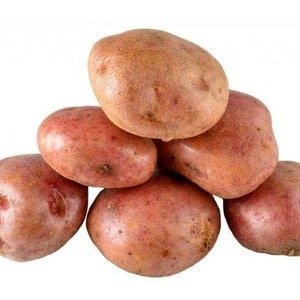 The average weight of ripe vegetables is 100-140 g, the shape is round, slightly elongated. The peel is smooth with a red tint, the number of eyes is moderate. The pulp is light yellow, there are no voids. Tubers are perfectly preserved after mechanical damage and can withstand any heat treatment without changing color.
The average weight of ripe vegetables is 100-140 g, the shape is round, slightly elongated. The peel is smooth with a red tint, the number of eyes is moderate. The pulp is light yellow, there are no voids. Tubers are perfectly preserved after mechanical damage and can withstand any heat treatment without changing color.
The taste is excellent. When cooking, due to the high starch content, potatoes can become overcooked, so they are removed from the heat 2-3 minutes before they are ready.
Keeping quality of ripe vegetables is not less than 91% of the total weight. The presentation is preserved during transportation over any distance.
Universal use of potatoes. Vegetables are used not only in households, but also in processing plants, where starch and chips are obtained from them.
Other “Dutch” for your site:
Characteristics of the variety
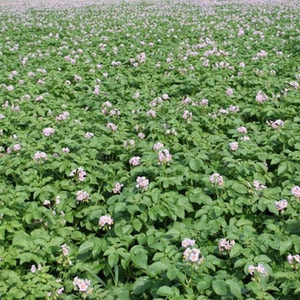 The bush is tall, erect, the stem is powerful. The leaves are large, dark green in color, moderate foliage.
The bush is tall, erect, the stem is powerful. The leaves are large, dark green in color, moderate foliage.
When blooming, large purple flowers are formed. with a red tint. The plant quickly adapts to weather changes and easily tolerates drought.
Ripening dates are mid-early. The first root crops can be tasted 75 days after planting, but full maturity occurs at 83-90 days.
The culture has increased resistance to potato cancer, golden nematode and potato mosaic virus. When carrying out preventive measures, the plant is not affected by late blight.
Productivity
The average yield of Kurazh is 160-270 c/ha. The quantitative indicator is influenced by many factors: proper care, climatic conditions, soil composition. If all requirements are met, the yield reaches 400 c/ha.
1 seedling produces 6-9 potatoes. They are all smooth, beautiful and almost the same size. The commercial yield of finished products is 85-99%.
How to grow
To obtain a rich and tasty harvest, complex agricultural practices are not required. It is enough to follow the standard rules for growing potatoes. Proper watering in combination with loosening, weeding and hilling ensure high-quality fruiting and keep the bushes healthy.
Pre-sowing treatment
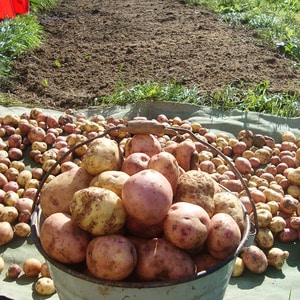 Tuber preparation begins a month before sowing. Each potato is carefully inspected for visible damage and disease.
Tuber preparation begins a month before sowing. Each potato is carefully inspected for visible damage and disease.
Spoiled seed material is disposed of. The remaining potatoes are laid out in a bright room at a temperature of +15...+17°C.
Tubers weighing no more than 100 g are selected for planting.. Large root crops are subsequently cut and planted in slices. The seed material is germinated within a month, otherwise it will not sprout.
Important! Immediately before planting, the tubers are treated with a Fitosporin solution. This is a contact fungicide that protects seed material and seedlings from damage by fungal diseases.
Planting dates and scheme
Planting dates for the Courage variety are especially important. The ideal period for sowing is the first ten days of May. In the southern regions, you can focus on the end of April, but do not forget about returning frosts.
Reference. A sharp cold snap negatively affects the development of bushes. The tubers are formed smaller and differ in taste.
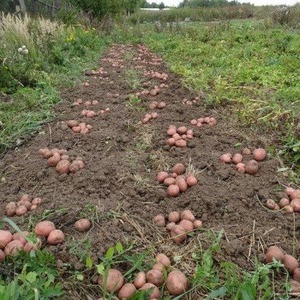 The soil is prepared in the fall: dug up with the addition of humus and wood ash. In the spring, the soil is dug up again. Before planting, a full range of mineral fertilizers is applied to the soil.
The soil is prepared in the fall: dug up with the addition of humus and wood ash. In the spring, the soil is dug up again. Before planting, a full range of mineral fertilizers is applied to the soil.
The tubers are planted to a depth of 8-10 cm. A little wood ash is placed in each hole and covered with earth.
Planting scheme: 35 cm - distance between holes, 70-75 cm - row spacing. With this planting scheme, it is convenient to care for potatoes, and the risk of diseases is reduced.
The soil temperature at the time of planting should be at least +10°C.
Further care for Courage potatoes
Cultivation care comes down to standard procedures, which even a novice gardener can handle.
Watering
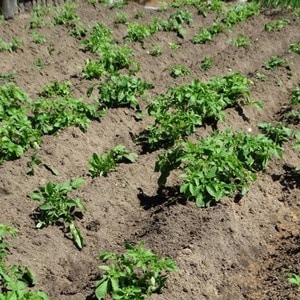 From the description of the variety it follows that it is drought resistant. But this does not mean that the plant need not be watered at all. Watering is required throughout the growing season, especially during budding and after flowering. The drier the weather, the more water is used for each bush.
From the description of the variety it follows that it is drought resistant. But this does not mean that the plant need not be watered at all. Watering is required throughout the growing season, especially during budding and after flowering. The drier the weather, the more water is used for each bush.
In normal climates, water consumption is no more than 6 liters, and on hot, sultry days it increases to 10 liters. The best indicator of watering is the top layer of soil. Do not allow it to dry out completely. The beds are kept moderately moist. In rainy weather, the amount of watering is reduced.
After watering, the wet soil is usually loosened and weeds are removed.. Loosening improves air exchange, which contributes to the normal functioning of the crop. Weeds carry many diseases and serve as a favorite habitat for various insect pests, so the proximity of cultivated plants to them is undesirable. In addition, weeds take a lot of useful substances from the ground, and seedlings suffer from a lack of nutrients.
Reference. An increased level of humidity in the beds leads to the development of fungal diseases.
Hilling is carried out three times per season. It protects the tubers from direct sunlight. For the first time, the plants are earthed up as soon as they grow to 10 cm. The second procedure occurs at the time of flowering, and the third is carried out when the seedlings reach 25 cm.
Feeding
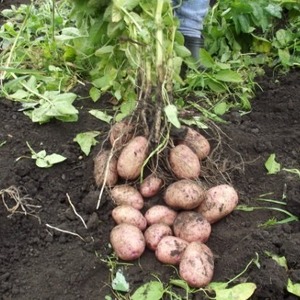 In addition to the main fertilizers, foliar fertilizers are used. The first is carried out after landing with poor seedling growth.Plants are fertilized with urea and ammonium nitrate. The crop also responds well to the introduction of nitrogenous substances at the initial stage.
In addition to the main fertilizers, foliar fertilizers are used. The first is carried out after landing with poor seedling growth.Plants are fertilized with urea and ammonium nitrate. The crop also responds well to the introduction of nitrogenous substances at the initial stage.
During flowering, apply a second fertilizing with a predominant content of phosphorus. Also at this stage they fertilize with organic matter - bird droppings in a ratio of 1:10. The resulting solution is treated between the rows after abundant watering.
At the time of tuber ripening The plants are fed with potassium fertilizers, thanks to which the root crops quickly gain weight and ripen.
Important! Potatoes take the main part of the nutrients for the formation of tubers from fertilizers applied during spring digging of the soil. Therefore, the land is abundantly supplied with humus and wood ash.
Diseases and pests
If you do not prevent late blight, the risk of its development increases. This fungal disease can destroy up to 70% of all plantings and easily spreads to other crops.
Protection against fungus begins with the preparation of seed, when sprouted tubers are treated with Fitosporin. During the growth of seedlings, the drugs “Ridomil” or “Avixil” are used. Preventive measures also include moderate watering, timely fertilizing and loosening the soil.
In case of disease, the affected areas of the plants are removed, and the seedlings are sprayed with “Fitosporin”.
Fungal spores are well preserved in weeds. This is another reason why you should clear your beds of them.
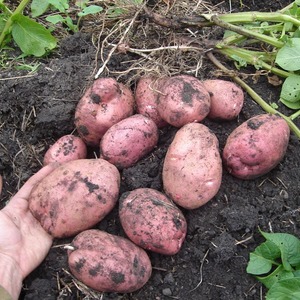 Insects that harm potatoes:
Insects that harm potatoes:
- Colorado beetle. It is collected by hand along with the larvae that appear on the inner surface of the leaves. When there is a large concentration of pests, the insecticide “Confidor” is used.
- Medvedka. It is difficult to notice, as it moves underground and damages the root system. Subsequently, the plant does not receive sufficient nutrition and dies. In the fight against mole crickets, the drug “Medvetox” is used, the granules of which are buried several centimeters into the ground.
- Aphid. The drug "Aktara" is used against it. It destroys pests, but is safe for humans. A sure sign of aphids appearing in the garden beds is a large number of ants. These are companions and protectors of aphids.
Daily inspection of seedlings helps to notice in time uninvited guests and the first signs of illness.
Read also:
Drought-resistant and productive potato variety Labadia
Collection, storage and use of crops
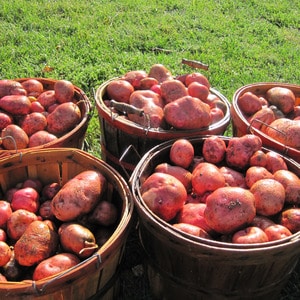 Harvesting begins at the end of August, having previously mowed all the tops. Potatoes dug out of the ground are left on the field to dry for several hours. Afterwards, the tubers are placed in wooden boxes and left in a cool, dry room.
Harvesting begins at the end of August, having previously mowed all the tops. Potatoes dug out of the ground are left on the field to dry for several hours. Afterwards, the tubers are placed in wooden boxes and left in a cool, dry room.
Harvest subject to long-term storage, does not lose its presentation and taste until spring.
Courage potatoes are used in households for preparing all kinds of dishes.. It is also used for processing in large industries to produce starch.
Advantages and disadvantages
The culture became widespread thanks to numerous benefits:
- drought resistance;
- good yield;
- ease of care;
- stable immunity to many diseases;
- breeding opportunities for sale;
- excellent taste;
- commercial appearance of tubers;
- resistance to long-term transportation;
- versatility in cooking.
As for the disadvantages, it should be noted susceptibility to late blight without pre-treatment.
For which regions is it best suited?
Judging by the photos and reviews of those who planted, Dutch culture can grow throughout Russia, as well as in neighboring countries. But Courage produces the richest harvest only in the Central region of Russia.
Reviews
Most gardeners leave only positive reviews about the crop.
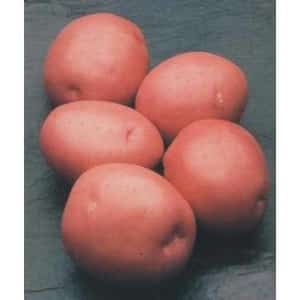 Antonina, Moscow: “I like this variety for its unpretentiousness and high yield. You can make anything you want from potatoes: first and second courses, pie filling, and all kinds of salads. The seedlings do not get sick, but I definitely carry out preventive measures against late blight. This is not the first year I have been planting Courage and I will plant it again.”.
Antonina, Moscow: “I like this variety for its unpretentiousness and high yield. You can make anything you want from potatoes: first and second courses, pie filling, and all kinds of salads. The seedlings do not get sick, but I definitely carry out preventive measures against late blight. This is not the first year I have been planting Courage and I will plant it again.”.
Anatoly, Lipetsk region: “I’m planting several early varieties for sale. The peculiarity of Courage is that it not only does not get sick, but also produces a larger harvest than other varieties. That’s why I plant it most of all, especially since the rounded tubers with red skin are readily sold out.”.
Conclusion
Dutch potatoes Courage have proven themselves only on the positive side. It is undemanding to care, has high productivity and stable immunity to many diseases.
The variety tolerates drought well and is subject to long-term storage. Thanks to its numerous advantages, this potato is appreciated by both gardeners and entrepreneurs.